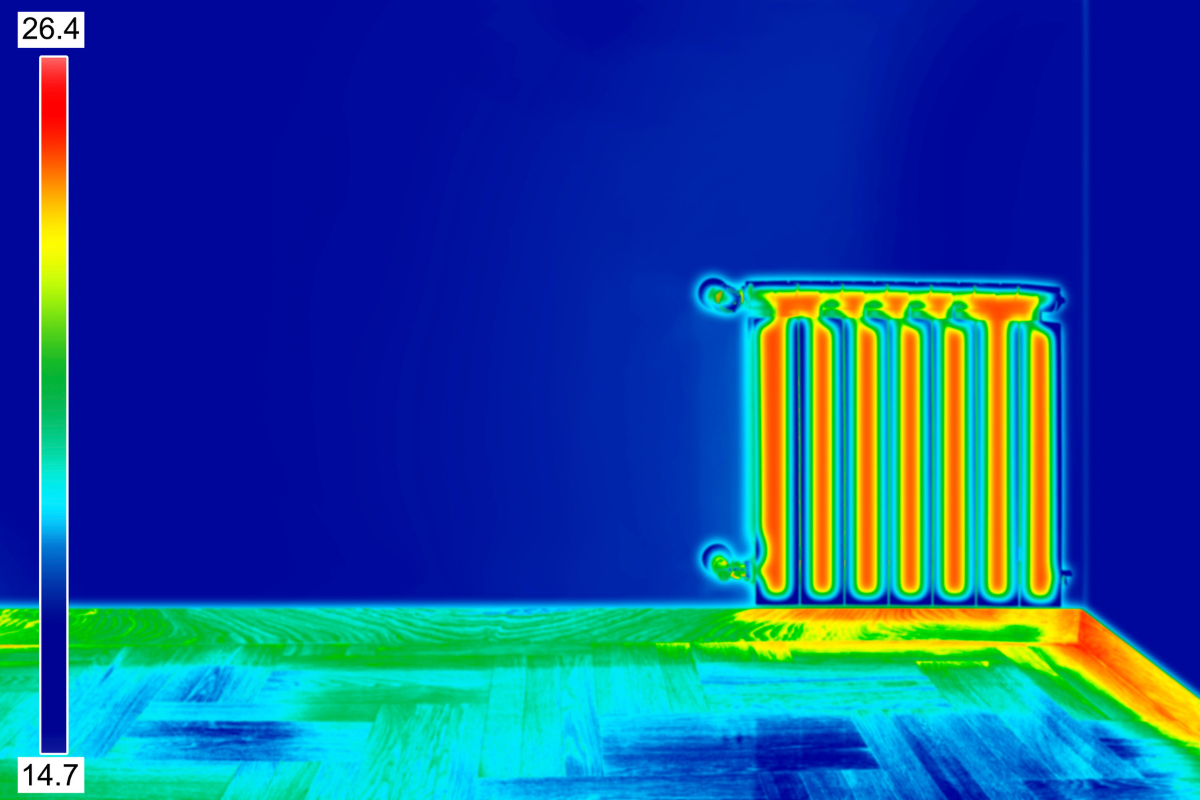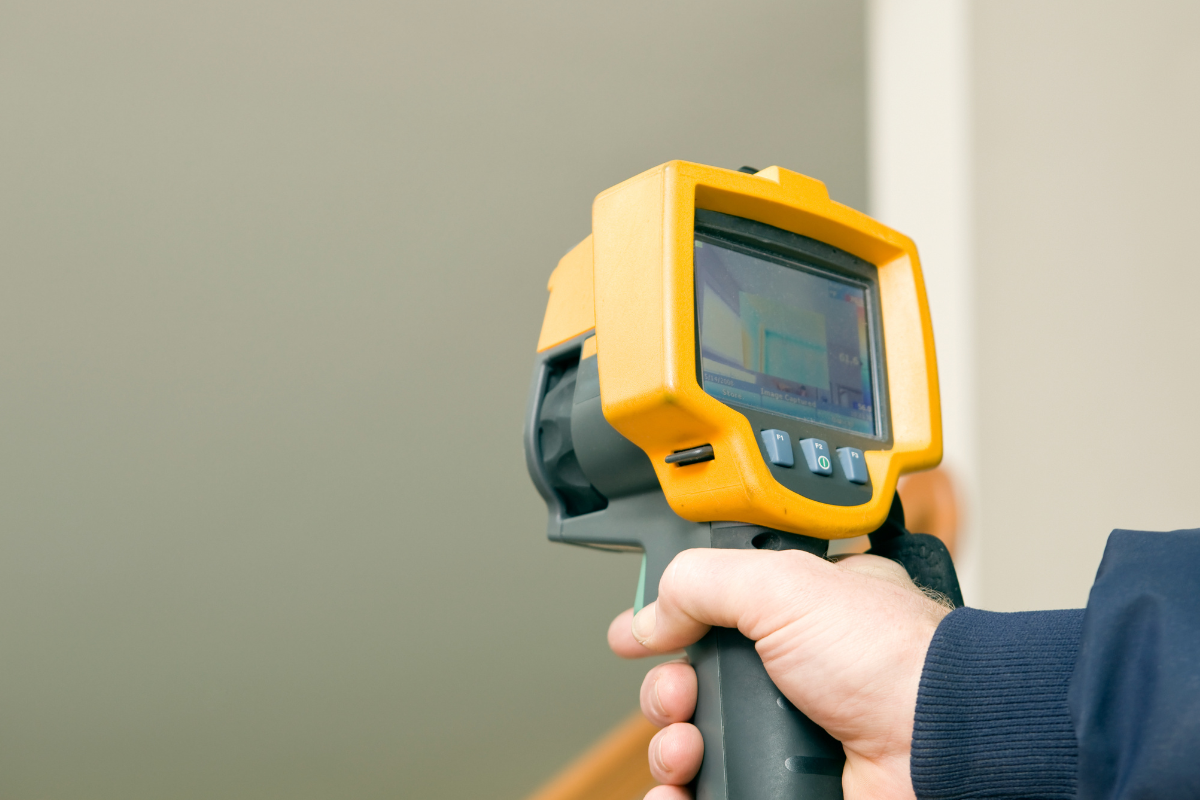Not all problems knock loudly. Some of the most expensive issues in your building hide in plain sight - completely invisible to the naked eye. Heat escaping through poorly insulated walls, cold bridging in roof spaces, hidden moisture quietly breeding mould behind plasterboard... Here’s the challenge: you can’t fix what you don’t know is broken. Enter thermal imaging - a technology that gives infrared “vision,” exposing those hidden inefficiencies and safety risks in buildings.
At a time when energy costs are high and compliance pressures are rising, the ability to see the unseen could be your most valuable tool. So, how to get started with thermal imaging?
Thermal imaging cameras detect variations in surface temperatures and translate them into scans with visible colour gradients - effectively creating a heat map of your building's performance.

What can you expect from a thermal imaging survey? The process is simple, non-intrusive, and fast. There’s no drilling, disruption, or downtime. A typical scan can be done in a few hours and delivers insights that might otherwise take weeks of manual inspections - or worse, go unnoticed until damage is done.
Once results are analysed, you receive a detailed report highlighting inefficiencies, risks, and clear recommendations for next steps - whether that’s targeted insulation, minor repairs, or preventative upgrades.
What is the benefit of thermal imaging? With its diverse applications, you can gain a significant advantage in maintaining building integrity, optimising energy efficiency, ensuring occupant comfort and safety, and ultimately reducing operational costs.
The insights provided by thermal imaging empower proactive decision-making and contribute to the long-term sustainability and value of their properties. Whether you’re retrofitting, improving EPC scores, or simply trying to reduce your heating bills, thermal imaging confirms what’s working and shines a light on what’s not.
You can also use the findings to support funding cases for upgrades, make informed asset management decisions, or schedule repairs before they become emergencies. It transforms guesswork into strategy.
One of the most significant benefits of thermal imaging is its ability to visualise heat transfer. Inefficient or missing insulation becomes apparent as areas of excessive heat loss (in colder months) or heat gain (in warmer months). This allows you to:
Identify thermal bridges: These are areas where materials with poor insulation properties create pathways for heat to escape or enter, often occurring at structural elements like concrete slabs or steel beams.
Detect insulation gaps and voids: Thermal cameras can reveal areas within walls, roofs, and floors where insulation is missing, compressed, or improperly installed.
Assess window and door performance: Air leaks around frames and through inefficient glazing are easily identified by temperature differentials. Addressing these issues leads to significant reductions in heating and cooling costs and improved occupant comfort.
Water ingress is a major concern for property integrity and occupant health. Thermal imaging can be a non-destructive method for identifying areas of elevated moisture within building materials. Water has a different thermal signature than dry materials, often appearing cooler due to evaporative cooling. This allows you to:
Locate hidden leaks: Roof leaks, plumbing leaks within walls or under floors, and condensation issues can be detected before they manifest as visible damage.
Trace the extent of water damage: Thermal imaging can help delineate the boundaries of moisture-affected areas, guiding targeted repairs and preventing unnecessary demolition.
Identify areas at high risk of mould growth: While thermal imaging doesn't directly detect mould, identifying persistently damp areas allows for proactive intervention to prevent mould proliferation and maintain healthy indoor air quality. Crucially, thermal imaging detects moisture, a precursor to mould, not mould itself.
Electrical systems are critical for building operation and safety. Overheating components are a major fire hazard and can lead to costly downtime. Thermal imaging provides a safe and efficient way to:
Detect loose connections: Poorly tightened electrical connections exhibit increased resistance, generating heat that is easily visible with a thermal camera.
Identify overloaded circuits: Components drawing excessive current will overheat, indicating a potential safety risk or the need for circuit redistribution.
Locate faulty motors and transformers: Overheating in these critical pieces of equipment can signal impending failure, allowing for preventative maintenance before a costly breakdown occurs.
Inspect solar panel installations: Thermal anomalies in solar panels can indicate faulty cells or connections, impacting energy generation efficiency and safety.
Heating, ventilation, and air conditioning (HVAC) systems are significant energy consumers and crucial for occupant comfort. Thermal imaging can help optimise their performance by:
Identifying ductwork leaks and insulation issues: Temperature variations along ductwork can indicate air leaks or inadequate insulation, leading to energy loss and reduced system efficiency.
Diagnosing malfunctioning equipment: Overheating motors, blocked coils, and faulty dampers can be identified through thermal signatures.
Verifying airflow and distribution: Observing the temperature of air exiting diffusers can reveal imbalances or blockages in the airflow system.
Detecting issues in boilers and chillers: Thermal anomalies can indicate problems with heat exchangers, pumps, or insulation.
Flat roofs, in particular, are prone to water ponding and subsequent leaks. Thermal imaging offers a non-destructive way to identify moisture trapped within the roofing membrane:
Locate subsurface moisture: During the cooler evening hours, trapped moisture retains heat longer than dry areas, making it visible with a thermal camera. This allows for targeted repairs without the need for exploratory coring.
Assess the effectiveness of repairs: Post-repair thermal scans can verify that the moisture issue has been resolved.
Beyond visible leaks, thermal imaging can help identify hidden plumbing problems:
Locate hot water leaks behind walls or under floors: The temperature difference between the leaking hot water and the surrounding materials is easily detectable.
Identify blockages in pipes: Restrictions in flow can sometimes cause temperature variations along the pipe.
It’s not. Compared to the cost of emergency repairs, tenant complaints, or wasted energy across a portfolio, a thermal imaging survey is often one of the most cost-effective steps you can take. Many clients recover the cost through savings within a matter of weeks or months.
There’s virtually no disruption during a thermal imaging survey. Scans can be scheduled around your team, and because the process is entirely non-invasive, it doesn’t interrupt operations or tenant activity.
You’re not expected to. At Karsons, we explain everything in plain English. Our engineers interpret the data and guide you on what to do next. You get actionable recommendations, detailed annotations and analysis of limitations, not just thermal photos.
That’s exactly the point. Thermal imaging is preventative. Its purpose is catching faults while they’re small, before they turn into downtime, tenant complaints, or spiralling costs.
If you have decided that thermal imaging might be useful for your building, there is one more aspect you need to look into. When considering thermal imaging for a commercial property, you have two main paths: investing in your own equipment and learning to use it, or hiring a qualified professional. Each approach has its own set of advantages and disadvantages.

Lower upfront cost, potentially (for basic equipment): If you only need to perform very basic scans occasionally, the initial investment in an entry-level thermal camera might seem lower than the cost of a professional service for a single inspection.
Convenience and control: You have direct control over when and how the inspections are performed, allowing for immediate checks if issues arise.
Flexibility for frequent checks: For ongoing monitoring or regular checks in specific areas, having your own camera offers flexibility without incurring repeated service fees.
Learning a new skill: You or your team can develop in-house expertise in thermal imaging.
Significant investment in quality equipment: To obtain accurate and reliable data for comprehensive building diagnostics, you'll likely need to invest in a mid-to-high-range thermal camera with adequate resolution, thermal sensitivity, and features. This can be a substantial upfront cost.
Steep learning curve: Interpreting thermal images accurately requires training and experience. Misinterpreting data can lead to incorrect diagnoses and wasted resources.
Time commitment for training and analysis: Learning to operate the camera effectively, understanding building science principles related to heat transfer and moisture, and analysing the resulting images takes significant time and effort.
Lack of independent, expert opinion: Your own interpretation might be biased or lack the broader perspective of an experienced professional who has seen a wide range of building issues.
Calibration and maintenance: Thermal cameras require periodic calibration to ensure accuracy, and you'll be responsible for this maintenance.
Liability concerns: If your DIY inspection misses a critical issue, you could face liability. Professional thermographers often carry insurance.
Report quality and acceptance: Reports generated in-house might lack the professionalism and detail required for insurance claims, legal documentation, or presenting to stakeholders.
Expertise and experience: Certified thermographers have the training, knowledge, and experience to conduct thorough inspections and accurately interpret complex thermal patterns.
High-quality equipment: Professionals use calibrated, high-resolution thermal cameras that provide detailed and reliable data.
Comprehensive reporting: You will receive a professional report with clear thermal and visual images, detailed analysis, and actionable recommendations.
Time savings: You and your team can focus on your core responsibilities while the professional handles the inspection and analysis.
Objective and unbiased assessment: A third-party professional provides an unbiased evaluation of your building's condition.
Insurance and liability coverage: Reputable thermography companies typically carry professional liability insurance.
Compliance with standards: Professionals often adhere to industry standards and best practices for thermal inspections.
Higher cost per inspection: The cost of hiring a professional for each inspection will likely be higher than the initial investment in basic DIY equipment.
Scheduling dependency: You need to coordinate schedules with the thermography service provider.
Less immediate access: You can't perform an immediate thermal check whenever a concern arises.
The best approach depends on your specific needs, budget, and the complexity of the inspections required. For occasional, basic checks, a DIY approach with a lower-end camera might suffice.
However, for comprehensive building diagnostics, critical issue identification, insurance purposes, and ensuring accuracy, hiring a qualified and certified thermal imaging professional is generally the recommended and more cost-effective option in the long run. Their expertise and high-quality equipment provide valuable insights and reduce the risk of misdiagnosis and overlooking critical problems.
Karsons Consulting are members of the Chartered Institute of Building Services Engineers, The Association of Consultancy and Engineering, British Institute of Facilities Managers and the Building Services Research and Information Association.